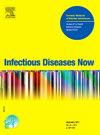HLA-A*03可能通过增强免疫反应来提供对长冠状病毒的保护
IF 2.2
4区 医学
Q2 INFECTIOUS DISEASES
引用次数: 0
摘要
COVID-19大流行导致了广泛的感染,很大一部分患者出现了被称为长COVID的持续症状。了解影响新冠肺炎易感性和严重程度的遗传因素对于制定有针对性的干预措施至关重要。目的探讨HLA等位基因、KIR受体及其相互作用对2020年初西班牙东南部地区感染新冠肺炎的患者发生Long COVID的影响。方法采用横断面前瞻性研究,纳入153例COVID-19患者。感染后3个月,采用血清和血样分析HLA-A、-B、-C、KIR基因分型及免疫学指标。Long COVID是在感染三年后根据持续症状被诊断出来的。结果71人发生长冠肺炎。HLA-A*03在长冠患者中的发生率低于非长冠患者(10.7%比30.5%,p = 0.001)。HLA-A*03患者的CD8+ T细胞比例高于其他同种异体患者(33.6±13.4% vs 28.7±10.8%,p = 0.033), KIR2DL1(1265±547 vs 1465±414 MFI, p = 0.031)和KIR3DL1(300.6±125.0 vs 398.9±131.0 MFI, p = 0.047)表达较低。HLA-A*03患者NK细胞中TIGIT抑制受体表达较低(73.7±12.2% vs 78.2±10.8%,p = 0.046)。结论hla - a *03可能通过增强CD8+ T细胞和NK细胞的免疫应答,对Long COVID发挥保护作用。需要在更大、更多样化的人群中进行进一步研究,以验证这些发现,并完善管理COVID-19后遗症的个性化医疗策略。本文章由计算机程序翻译,如有差异,请以英文原文为准。
HLA-A*03 may confer protection against long COVID through an enhanced immune response
Background
The COVID-19 pandemic has led to widespread infection, with a significant subset of patients developing persistent symptoms known as Long COVID. Understanding the genetic factors influencing Long COVID susceptibility and severity is crucial for development of targeted interventions.
Objective
This study aimed to evaluate the impact of HLA alleles, KIR receptors, and their interactions on the development of Long COVID in patients from southeastern Spain having contracted COVID-19 during the early 2020 pandemic wave.
Methods
A cross-sectional prospective study enrolled 153 COVID-19 patients. Three months post-infection, HLA-A, –B, –C, KIR genotyping and immunological variables were analyzed using serum and blood samples. Long COVID was diagnosed three years post- infection based on persistent symptoms.
Results
Among the participants, 71 developed Long COVID. HLA-A*03 was less frequent in Long COVID compared to non-Long COVID patients (10.7 % vs. 30.5 %, p = 0.001). Patients with HLA-A*03 had a higher percentage of CD8+ T cells than patients with other allotypes (33.6 ± 13.4 % vs 28.7 ± 10.8 %, p = 0.033) and showed lower expression of KIR2DL1(1265 ± 547 vs 1465 ± 414 MFI, p = 0.031) and KIR3DL1 (300.6 ± 125.0 vs 398.9 ± 131.0 MFI, p = 0.047). Moreover, NK cells in HLA-A*03 patients showed lower expression of the TIGIT inhibitory receptor (73.7 ± 12.2 % vs 78.2 ± 10.8 %, p = 0.046).
Conclusion
HLA-A*03 may play a protective role against Long COVID, potentially through enhanced immune responses involving CD8+ T cells and NK cells. Further research in larger, diverse cohorts is needed to validate these findings and to refine personalized medicine strategies for managing COVID-19 sequelae.
求助全文
通过发布文献求助,成功后即可免费获取论文全文。
去求助
来源期刊

Infectious diseases now
Medicine-Infectious Diseases
CiteScore
7.10
自引率
2.90%
发文量
116
审稿时长
40 days
 求助内容:
求助内容: 应助结果提醒方式:
应助结果提醒方式:


